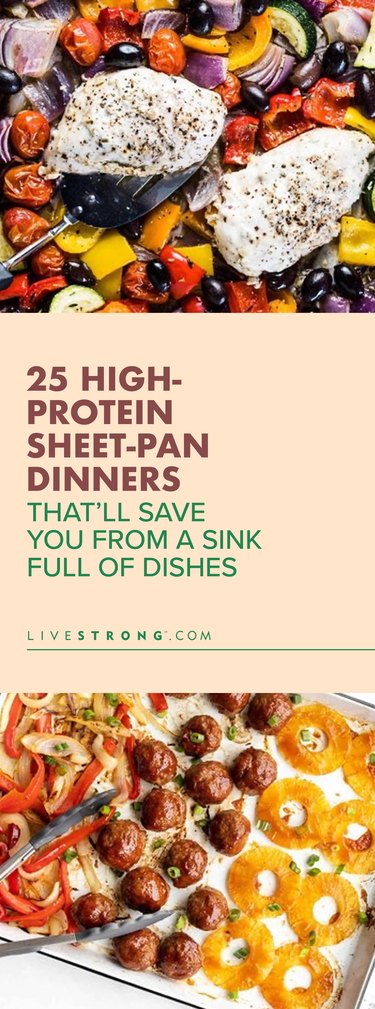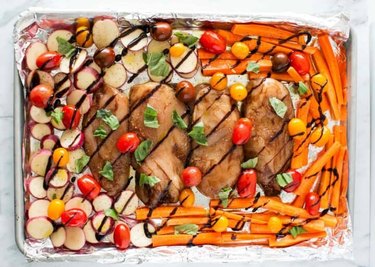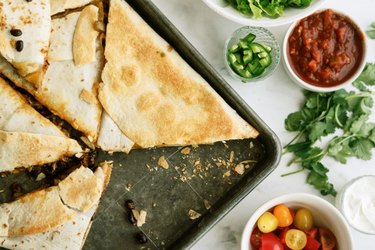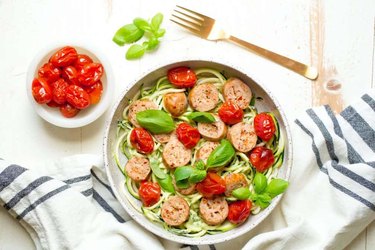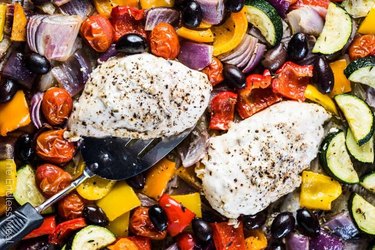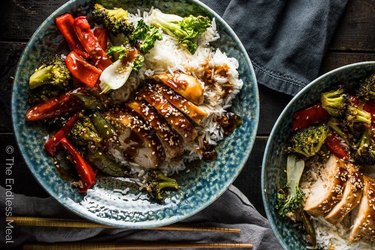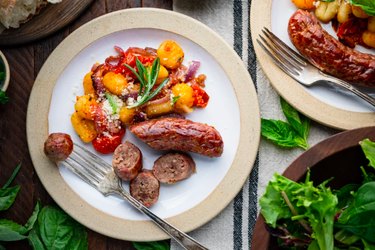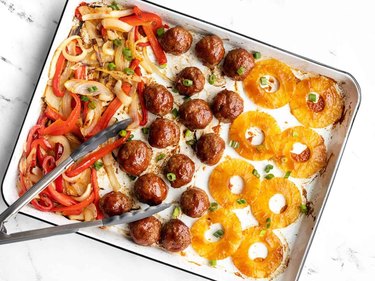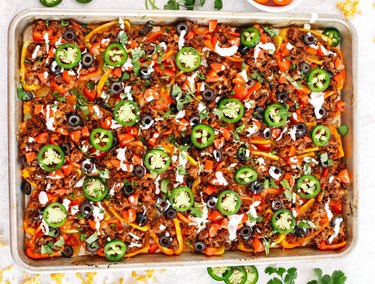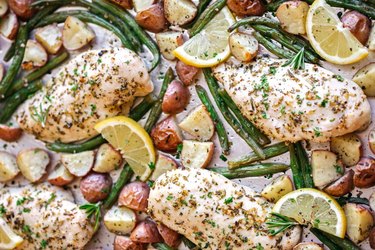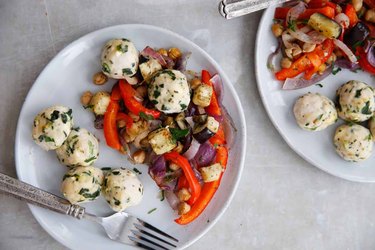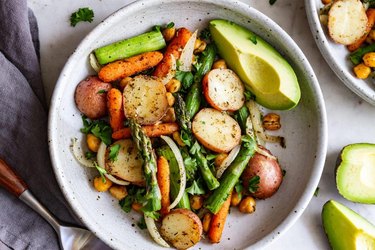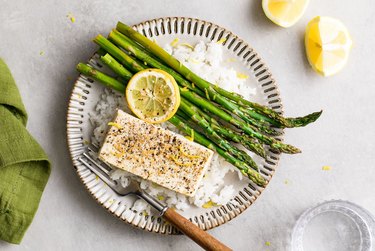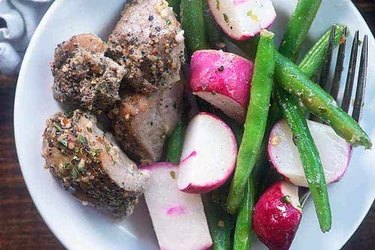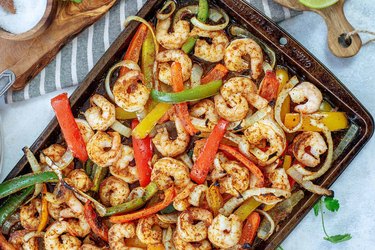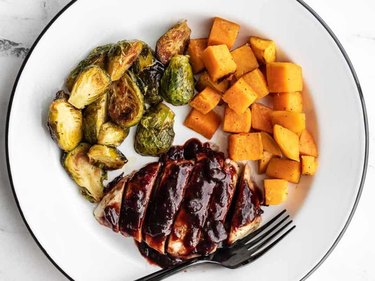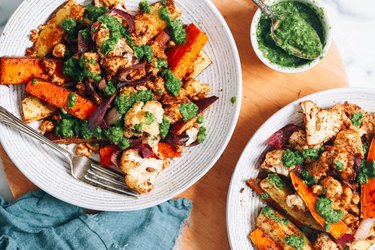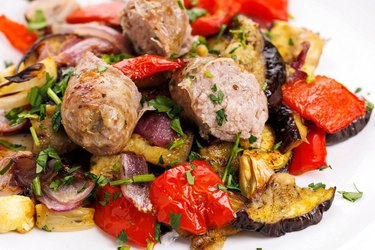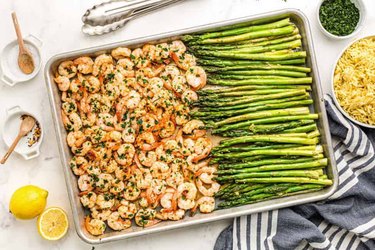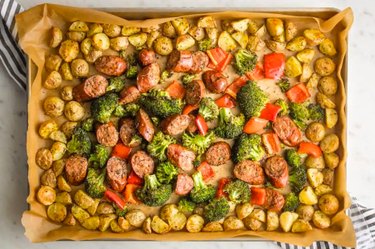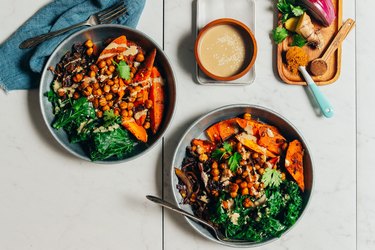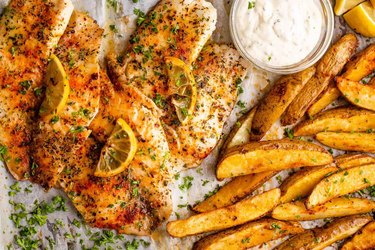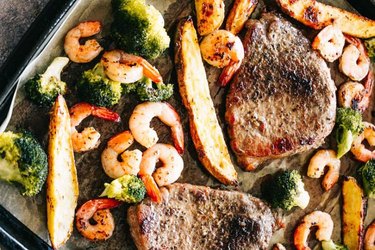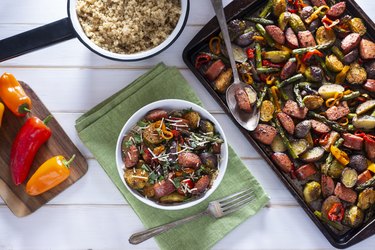
When it's possible to make an entire dinner with one pan in less than an hour and with minimal clean-up, you've got us hooked at hello. That's why we love sheet pan dinners: They're quick, easy and don't require an hour of washing dishes after dinner. And in most cases, they're really nutritious, too.
To give you a little dinner inspo, we rounded up 25 sheet pan recipes that are high in protein and flavor but minimal in the clean-up department. Don't be surprised if you find yourself wanting to cook them all.
Video of the Day
Video of the Day
1. Sheet Pan Chicken Shawarma
- 436 calories
- 39 grams of protein
Including sweet potatoes in this recipe provide fiber and beta-carotene, says Andrea Mathis, RD of Beautiful Eats and Things. And the best thing is it comes together in less than 30 minutes.
Get the Sheet Pan Chicken Shawarma recipe and nutrition info from Wholesomelicious.
2. One-Pan Balsamic Chicken and Veggies
- 272 calories
- 23 grams of protein
"This recipe contains a variety of hearty vegetables, including carrots and broccoli," Mathis says. "Carrots are packed with several nutritious components, such as potassium, antioxidants and vitamin A."
Get the One-Pan Balsamic Chicken and Veggies recipe and nutrition info from I Heart Naptime.
3. Sheet Pan Ground Beef Quesadilla
- 363 calories
- 27 grams of protein
Quesadillas are a great vehicle for getting in extra veggies. "Including black beans contains several nutritious benefits including high levels of flavonoids, particularly anthocyanins, which helps to fight the effects of aging and oxidative stress," Mathis says.
Get the Sheet Pan Ground Beef Quesadilla recipe and nutrition info from Six Sisters Stuff.
4. Sheet Pan Sausage, Pesto and Roasted Tomato Noodle Bowls
- 433 calories
- 26 grams of protein
Replacing traditional pasta with zucchini noodles, like in this recipe, makes this a satisfying low-carb option for those watching their carb intake, Mathis says. Not to mention, zucchini is an excellent source of vitamin A.
Get the Sheet Pan Sausage, Pesto and Roasted Tomato Noodle Bowls recipe and nutrition info from Wholesomelicious.
5. Sheet Pan Tzatziki Chicken
- 380 calories
- 29 grams of protein
"Instead of the traditional green bell peppers, this recipe calls for yellow and orange bell peppers," Mathis says. "Yellow and orange bell peppers are an excellent source of vitamin C, vitamin A and potassium."
Get the Sheet Pan Tzatziki Chicken recipe and nutrition info from The Endless Meal.
6. Asian-Style Chicken Sheet Pan Dinner
- 277 calories
- 21 grams of protein
This dinner recipe gives you the option to serve it with rice or cauliflower rice to make it more filling, Mathis says. It also includes bok choy, a cruciferous vegetable full of nutrients, especially vitamins C and K.
Get the Asian-Style Chicken Sheet Pan Dinner recipe and nutrition info from The Endless Meal.
7. Sheet Pan Gnocchi With Sausage
- 584 calories
- 20 grams of protein
"This recipe provides a satiating balance of protein, good fat and carbohydrates," says Mia Syn, RD, of Nutrition by Mia. To boost the nutrition of this dish and lower the carbohydrates, consider cauliflower gnocchi instead of the traditional, carb-heavy potato version.
Get the Sheet Pan Gnocchi With Sausage recipe and nutrition info from The Seasoned Mom.
8. 20-Minute Sheet Pan Shrimp Tacos
- 258 calories
- 32.5 grams of protein
"Shrimp is a lean protein source that helps contribute to your recommended two servings of seafood per week," Syn says. "It also provides key nutrients including B vitamins, zinc and selenium."
Get the 20-Minute Sheet Pan Shrimp Tacos recipe and nutrition info from The Seasoned Mom.
9. Sheet Pan BBQ Meatballs
- 549 calories
- 28.6 grams of protein
Ground turkey is a nutritious protein to use for homemade meatballs and leaner than ground beef, Syn says. "Replace the breadcrumbs with equal parts whole-grain oat flour to boost the fiber and nutrition of the dish."
Get the Sheet Pan BBQ Meatballs recipe and nutrition info from Budget Bytes.
10. Sheet Pan Loaded Bell Pepper Nachos
- 220 calories
- 18 grams of protein
This recipe skips tortilla chips and uses bell peppers for the nacho base. "For a leaner protein option, replace ground beef with ground turkey or chicken," Syn suggests.
Get the Sheet Pan Loaded Bell Pepper Nachos recipe and nutrition info from Eat Yourself Skinny.
11. Sheet Pan Lemon Rosemary Chicken and Potatoes
- 396 calories
- 39.4 grams of protein
"This meal is balanced with lean protein, energizing carbohydrates and healthy fats," Syn says. "Lemon juice and seasonings flavor this dish for minimal calories."
Get the Sheet Pan Lemon Rosemary Chicken and Potatoes recipe and nutrition info from Eat Yourself Skinny.
12. Sheet Pan Greek Meatballs With Veggies and Chickpeas
- 386 calories
- 39.7 grams of protein
Adding spinach to the meatball mixture helps to sneak in an extra serving of vegetables, which is great for picky eaters (they'll never know!). Fresh or frozen spinach is loaded with fiber and high in vitamins and minerals, too.
Get the Sheet Pan Greek Meatballs With Veggies and Chickpeas recipe and nutrition info from Lexi's Clean Kitchen.
13. Herbed Potato, Asparagus and Chickpea Sheet Pan Dinner
- 325 calories
- 14 grams of protein
Sheet pan dinners work for Meatless Mondays, too. Just be sure to include ingredients that are nutritionally diverse like this recipe does with potatoes, chickpeas and a variety of veggies.
Get the Herbed Potato, Asparagus and Chickpea Sheet Pan Dinner recipe and nutrition info from The Simple Veganista.
14. Lemon Pepper Tofu Sheet Pan Dinner
- 328 calories
- 16.8 grams of protein
Adding a carbohydrate like rice, quinoa or farro to this sheet pan dinner will make this a more well-rounded meal. Or if you want to keep it a one-pot meal, add a few white or sweet potatoes to the sheet pan before roasting.
Get the Lemon Pepper Tofu Sheet Pan Dinner recipe and nutrition info from The Simple Veganista.
15. Low-Carb Sheet Pan Pork and Veggies
- 744 calories
- 96 grams of protein
Radishes are a great addition to this recipe with their punchy, peppery flavor. One cup of radishes clocks in at just 20 calories and 2 grams of fiber, according to the USDA.
Get the Low-Carb Sheet Pan Pork and Veggies recipe and nutrition info from Buns In My Oven.
16. Sheet Pan Shrimp Fajitas
- 204 calories
- 27 grams of protein
Feed the entire family with this sheet pan dinner. To make it a complete meal, serve these shrimp fajitas with whole-grain tortillas and your favorite taco-style toppings, such as guac and spicy salsa.
Get the Sheet Pan Shrimp Fajitas recipe and nutrition info from That Low Carb Life.
17. Sheet Pan Cranberry Chicken Dinner
- 552 calories
- 35.9 grams of protein
This recipe is ideal for fall and winter because it calls for two winter produce options — sweet potatoes and Brussels sprouts. If you don't have sweet potatoes, consider swapping for butternut squash or even red or white potatoes.
Get the Sheet Pan Cranberry Chicken Dinner recipe and nutrition info from Budget Bytes.
18. Tandoori Tofu Sheet Pan Dinner
- 493 calories
- 19.7 grams of protein
With just seven ingredients, this dish is loaded with flavors reminiscent of your favorite Indian-inspired takeout. And because there's protein, veggies and carbohydrates included, it's truly a one-pan wonder.
Get the Tandoori Tofu Sheet Pan Dinner recipe and nutrition info from Minimalist Baker.
19. Sheet Pan Sausage, Eggplant and Peppers
- 525 calories
- 19 grams of protein
This plant-boosted spin on traditional sausage and peppers gets an extra dose of fiber, vitamins B6 and potassium, thanks to the eggplant, says Nicole Rodriguez, RD. It also offers a source of antioxidants including lutein, which promotes eye health.
Get the Sheet Pan Sausage, Eggplant and Peppers recipe and nutrition info from The Lemon Bowl.
20. Shrimp and Asparagus Sheet Pan Meal
- 372 calories
- 35 grams of protein
"Shrimp delivers so much nutritional bang for its buck," Rodriguez says. "Shrimp is especially good if you're looking to amp up protein at meals for a few calories."
Get the Shrimp and Asparagus Sheet Pan Meal recipe and nutrition info from The Cookie Rookie.
21. Sheet Pan Chicken Sausage With Broccoli, Peppers and Potatoes
- 347 calories
- 17 grams of protein
"Potatoes actually count as a vegetable," Rodriguez says. "Potatoes are full of cellular fluid-regulating potassium, vitamin C for immune support and B6."
Get the Sheet Pan Chicken Sausage With Broccoli, Peppers and Potatoes recipe and nutrition info from Nourish and Fete.
22. Curried Sweet Potato and Chickpeas
- 581 calories
- 16.7 grams of protein
Including canned beans in your diet is a smart choice, Rodriguez says. And combining chickpeas with sweet potatoes, as in this recipe, results in a one-two punch of fiber that can be enjoyed as a main or side dish.
Get the Curried Sweet Potato and Chickpeas recipe and nutrition info from Minimalist Baker.
23. Sheet Pan Fish and Chips
- 314 calories
- 37 grams of protein
This meal is high in lean protein and complex carbs. But opt for frozen fish and potatoes, Rodriguez says. "Their nutritional content is near equal and can get this meal ready in half the time."
Get the Sheet Pan Fish and Chips recipe and nutrition info from Diethood.
24. Sheet Pan Steak and Shrimp Dinner
- 522 calories
- 53 grams of protein
"Lean beef ups the satisfaction factor in this dish," Rodriguez says. "When choosing cuts of lean beef, seek those labeled with the words loin, top and round."
Get the Sheet Pan Steak and Shrimp Dinner recipe and nutrition info from Diethood.
25. Sheet Pan Baked Eggs With Roasted Spring Vegetables
- 213 calories
- 12 grams of protein
Enjoy this protein-rich meal for breakfast, lunch or dinner. To add even more flavor, toss in your favorite seasonings and herbs to boost flavor without adding extra calories.
Get the Baked Eggs With Roasted Spring Vegetables recipe and nutrition info from Cotter Crunch.
